
Daniel Chester French’s great statue of Abraham Lincoln at the Lincoln Memorial in Washington, D.C. (Photo by Michael E. Grass)
WASHINGTON — I really should be starting my Lincoln Highway adventure at Times Square in New York City, the highway’s true eastern terminus. But I live in the nation’s capital, so starting on one of the highway’s auxiliary routes is more sensible. (I’ll be detailing some of the route in New York and New Jersey after I join up with the mainline of the highway up in Pennsylvania.)
And in any regard, starting at the Lincoln Memorial makes sense. It’s an important spot.
The national monument to the Great Emancipator, sitting at the western end of the great east-west axis that includes the Washington Monument, U.S. Capitol and the National Mall, is probably the most well-known representation of Lincoln anywhere.
I’ve been to the Lincoln Memorial countless times and it’s among my favorite monuments in the nation’s capital. A lot of locals like to enjoy the monuments at night when there are fewer tourists — Richard Nixon once made a bizarre impromptu pre-dawn visit to the Lincoln Memorial in what’s called the “weirdest day” of his presidency — but I think it’s fascinating to go when it’s packed with people.
Why? Am I a glutton for punishment? No. When it’s crowded with visitors, you get to witness something that’s similar to a religious pilgrimage. The great Doric temple, designed by Henry Bacon and completed in 1922, is accessed by a grand and somewhat imposing staircase. It’s certainly not like the climb up to the Acropolis in Athens — which I did back on a sweltering summer day in 1996 during a high school Latin Club trip to Greece — but the experience is similarly humbling. You feel tiny in comparison to your surroundings, especially when you turn around to see the grand expanse of the great public space stretching beyond the Washington Monument to the east.
Post continues below …
- The Lincoln Memorial, viewed from the east. (Photo by Michael E. Grass)
- The Lincoln Memorial’s steps and outer colonnade. (Photo by Michael E. Grass)
- The Lincoln Memorial offers one of the best views in the nation’s capital, looking east. (Photo by Michael E. Grass)
- A close-up look at the memorial’s Doric columns and ornamentation. (Photo by Michael E. Grass)
- The Lincoln statue looms large in the memorial’s inner chamber. (Photo by Michael E. Grass)
- Another look at the Lincoln statue (Photo by Michael E. Grass)
Approaching the great memorial from the east along the reflecting pool, visitors catch a glimpse of Daniel Chester French’s great statue of Lincoln. But you don’t appreciate the scale of the whole site until you’re in the inner sanctum with the seated Lincoln, almost Zeus-like from his commanding perch.
This representation of Lincoln is not without its critics, who have said the grand imperial setting dehumanizes Lincoln, who is ordinarily known as a humble man. When Lewis Mumford visited the Lincoln Memorial, he wrote, according to The Wall Street Journal:
One feels not the living beauty of our American past, but the mortuary air of archaeology. Who lives in that shrine, I wonder — Lincoln … or the generation that took pleasure in the mean triumph of the Spanish American [War], and placed the imperial standard in the Philippines and the Caribbean?
Regardless of whether Lincoln’s memorial is overly imperialistic — a criticism, I should note, that is often directed at the National World War II Memorial about six blocks to the east — it is permanently part of the American story.
Post continues below …

Singer Marian Anderson views the great statue of Lincoln after singing on the steps of the Lincoln Memorial in 1939. (Photo from the Harris & Ewing Collection at the Library of Congress)
I don’t have to detail the famous scenes from American history that have played out on the steps of the Lincoln Memorial. Two major events in the nation’s struggle for civil rights, Martin Luther King’s delivery of his “I Have a Dream” speech and Marian Anderson singing “My Country ‘Tis a Thee,” will always be inextricably linked to the Lincoln Memorial, with Honest Abe himself looming in the background, albeit tucked away beyond the outer colonnade.
So why would you want to subject yourself to the legions of tourists that crowd the memorial? Take a moment to find the handful of people actually taking in the meaning of the great space. You’ll spot them among the chaos gazing up at the walls. They’re usually standing adjacent to one of the giant columns that separates the main chamber from the side chambers, carefully reading every word of the inscriptions of the Gettysburg Address and Lincoln’s second Inaugural address. Those two inscriptions are perhaps two of the most important and powerful known in American oratory. We often forget the meaning and impact of Lincoln’s words. That’s why they’re inscribed for all to read. It’s hard not to read them.
But you don’t get the same type of pilgrimage experience at the Washington Monument or the Jefferson Memorial. Those sites are certainly big national attractions, but it’s at the Lincoln Memorial where ordinary visitors can be instantly transformed into contemplative pilgrims trying to extract great meaning from Lincoln’s legacy. While George Washington and Thomas Jefferson certainly loom large in American history, Lincoln had more of a transformative impact on the nation. He was someone who not only helped save the Union but define it.
His memorial creates a stirring starting point for my Lincoln Highway journey, even if I’m not on the main part of the highway itself.
***
According to the Lincoln Highway Association’s official map of the highway, the auxiliary route in Washington, D.C., heads toward the White House via Constitution Avenue and 17th Street NW.
On its way out of town, the route travels north on 16th Street NW, northwest along Massachusetts Avenue and Embassy Row. Tucked away on a wooded ridge near the Vice President’s Residence, is a monument to Kahlil Gibran, one of my favorite off-the-radar memorials in the nation’s capital.
As part of a special message Gibran wrote for young Americans of Syrian origin, the great Lebanese-American poet, artist and thinker mentioned Lincoln. It’s not part of the memorial here, but it’s wonderful example of Gibran’s work:
I believe in you, and I believe in your destiny. I believe that you are contributors to this new civilization.
I believe that you have inherited from your forefathers an ancient dream, a song, a prophecy, which you can proudly lay as a gift of gratitude upon the lap of America.
I believe you can say to the founders of this great nation, “Here I am, a youth, a young tree, whose roots were plucked from the hills of Lebanon, yet I am deeply rooted here, and I would be fruitful.”
And I believe that you can say to Abraham Lincoln, the blessed, “Jesus of Nazareth touched your lips when you spoke, and guided your hand when you wrote; and I shall uphold all that you have said and all that you have written.” …
Post continues below …
The Lincoln Highway’s auxiliary route heads north toward Maryland along Wisconsin Avenue past the National Cathedral, where there’s a modest statue of Lincoln tucked away off the nave and in front of an inscription of his farewell address to the citizens of Springfield, Ill., before he left for the nation’s capital. There are different versions of what Lincoln’s remarks, but they’re stirring nonetheless, knowing the tough road he and the nation would face:
I now leave, not knowing when or whether ever I may return, with a task before me greater than that which rested upon Washington. Without the assistance of that Divine Being who ever attended him I can not succeed. With that assistance I can not fail.
As we all know, Lincoln would never see Springfield again.
***
Nearby at Fort Gaines in Tenleytown, Lincoln once ate what he described, according to Jan. 9, 1862, edition of The Washington Star, as “the best meal he had had in Washington,” courtesy of the New York 55th Zouaves, a “French regiment” known for its good cooking. There’s no marker to commemorate the meal, but there are plenty of other Lincoln sites in the nation’s capital.
Other Lincoln sites in Washington, D.C.

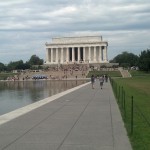
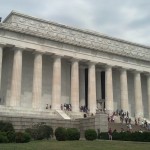
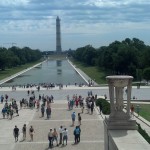
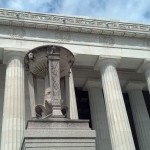
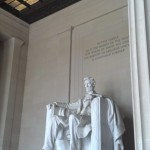
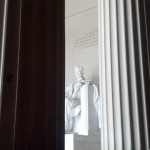
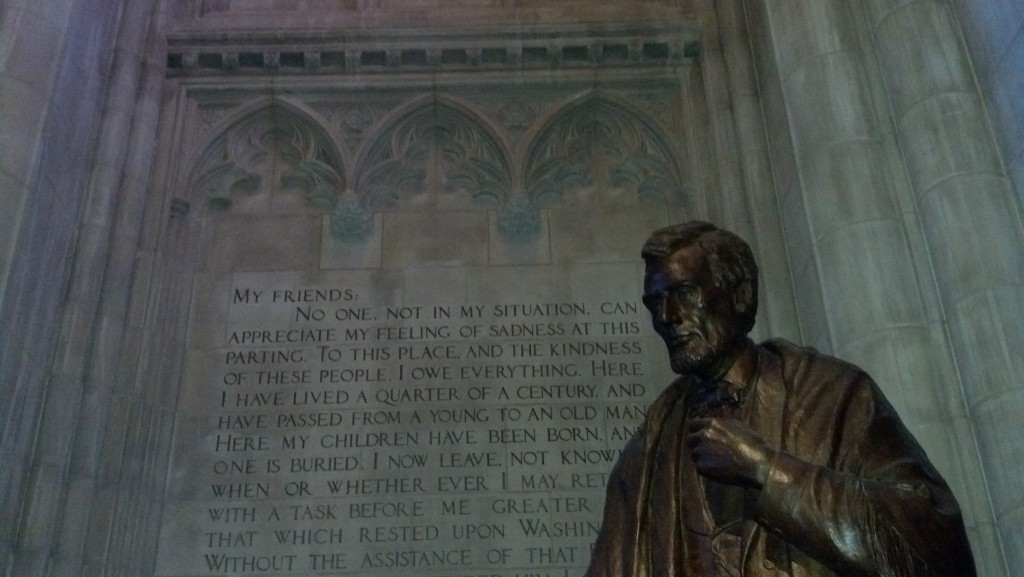
Pingback: Abraham Lincoln in Gettysburg | The Lincoln Highway Guide
Pingback: A Quick Fast Forward to the Western Terminus | The Lincoln Highway Guide